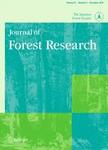版权所有:内蒙古大学图书馆 技术提供:维普资讯• 智图
内蒙古自治区呼和浩特市赛罕区大学西街235号 邮编: 010021

作者机构:Univ British Columbia Dept Forest & Conservat Sci Fac Forestry 2424 Main Mall Vancouver BC Canada Appl Mammal Res Inst Summerland BC Canada
出 版 物:《JOURNAL OF FOREST RESEARCH》 (森林研究杂志)
年 卷 期:2018年第23卷第6期
页 面:380-386页
核心收录:
学科分类:0907[农学-林学] 08[工学] 0829[工学-林业工程] 09[农学]
基 金:Forest Science Program (British Columbia Ministry of Forests and Range) Louisiana-Pacific Canada Ltd Applied Mammal Research Institute
主 题:Coniferous tree seedlings feeding damage Myodes gapperi plantations red-backed voles
摘 要:Although Eurasian species of Myodes voles are indeed pest species in forestry, it is not clear if the southern red-backed vole (Myodes gapperi), a closed-canopy species in western North America, also feeds on tree seedlings. Thus, we tested the hypotheses (H) that (H-1) abundance of M. gapperi would dominate the vole population immediately post-clearcutting and then disappear, and (H-2) while at high densities, incidence of mortality from feeding damage to newly planted tree seedlings by M. gapperi would be comparable to that reported for long-tailed voles (Microtus longicaudus). We live-trapped both species of voles, and measured feeding damage to planted trees, on seven replicate sites for the first 2 years after clearcutting near Golden, British Columbia, Canada. Population changes of M. gapperi and M. longicaudus were essentially the converse of one another in the first 2 years post-harvest. Red-backed voles were the dominant species in the first year and long-tailed voles were prominent in the second year. M. gapperi did not persist on these cutover sites and was at, or near, extirpation after 2 years post-harvest, and hence H-1 seemed to be supported. The range of tree mortality by red-backed voles was near the overall mean percentage tree mortality (33.9 +/- 4.8%) by M. longicaudus, and hence H-2 seemed to be supported. If new plantations have to survive relatively high numbers of two vole species and their feeding damage up to 4-5 years after harvest, then it may be worthwhile to delay planting until vole numbers have declined.